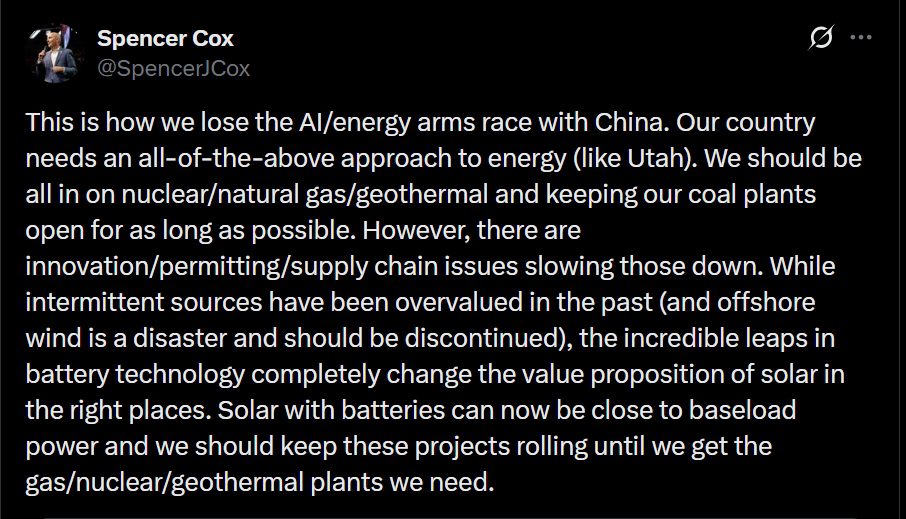Arson Alone Does Not Explain the Palisades Fire
The Drain is a weekly roundup of environmental and climate news from Legal Planet.

When federal prosecutors charged a man last week with intentionally starting a brushfire that was suppressed but smoldered and ultimately became the Palisades fire, arson became the focus of attention all week. The city’s after-action report about the fire was totally overshadowed by questions around the suspect. What was his motive? Is there strong evidence?
It’s almost as if arson became the sole explanation for one of the state’s most destructive fires. That would be a mistake. People are often the cause of wildfire ignitions, but that’s just how they start.
Truth is, the Palisades fire’s nearly unprecedented intensity had less to do with how it started, and more to do with the climate and weather conditions that fueled it. That’s according to my UCLA colleague and climate scientist Alex Hall, who helped perform a rapid analysis in January with UCLA’s Climate & Wildfire Research Initiative. It found that L.A. fire fuels were 25% drier due to climate change when the Palisades and Eaton fires began. Another UCLA study in August found that climate change was responsible for extending California’s annual wildfire season by up to a month and a half.
“Most of Southern California’s largest wildfires occur during Santa Ana wind events, and almost all of those are started by people, since there are virtually no natural ignition sources during those periods,” Hall says. “What made the January 2025 fires so destructive wasn’t the ignition alone, but the fact that vegetation had been dried far beyond normal by unusually high summer temperatures, and likely further stressed by warm conditions during the winds themselves.”
Very little of last week’s media coverage of the arrest mentioned the climate-fueled weather conditions that fed the fire. That’s a mistake. It’s something I plan to analyze in greater detail later this month.
One notable exception was Jim Rainey, who writes the LA Times’ Essential California newsletter. He raised a more existential question: “Who bears responsibility for the fire,” he wrote, “the alleged arsonist? The fire crews and their superiors who apparently didn’t do enough to make sure the embers of Jan. 1 had been entirely defeated? How about the fossil fuel producers and emitters (a.k.a. all of us) who have helped warm the planet and create the preconditions for disaster?”
All of the above?

Another headline that got less attention last week had to do with “private corporate land acquisition” complicating the rebuilding effort. Homes in Altadena that burned in the Eaton Fire are being disproportionately bought up by corporate developers, according to a recent analysis by Strategic Actions for a Just Economy. Of 241 properties sold through September, more than half went to corporate developers, Erin Stone reports at LAist. A similar post-disaster land grab has been happening in Maui two years after the wildfire there, as Grist reported this week.
Let us not forget that there was actually a bill in the California Legislature this session that sought to prevent this kind of problem by encouraging the creation of rebuilding authorities. That effort was scuttled. My Emmett Institute colleague Julia Stein helped lead a Blue-Ribbon Commission on wildfire rebuilding that recommended a Resilient Rebuilding Authority.
Stein is quoted in this deep dive about fire recovery policy by Alissa Walker that was just published in the second issue of the Los Angeles Review of Architecture. “One important thing a Resilient Rebuilding Authority could do is allow the state to buy out the properties of people who either can’t rebuild or don’t want to do it themselves,” Walker writes. Maybe next year.
Welcome to The Drain, a weekly roundup of environmental and climate news. Our song of the week is “Fire” by Waxahatchee, which is more about rebuilding than about destruction. Here’s what else is happening…
More from California
Well, that’s it, folks. The unofficial “Energy Affordability” Legislative Session is officially wrapped. Here’s some of what Gov. Newsom recently signed.
AB 1167, the California Ratepayer Protection Act aims to put an end to the use of ratepayer funds for political lobbying and strengthen enforcement against investor-owned utilities that illegally use ratepayer funds. My Emmett Institute colleague Denise Grab blogged about how the bill saves ratepayers money.
SB 79 spurs denser housing development near major transit stops in big cities. It’s one of the most ambitious bills of the session.
AB 531 will allow geothermal power plants to get certified through the California Energy Commission’s streamlined opt-in process. Newsom signed it but not AB 527 aimed to streamline geothermal certification by providing a CEQA exemption for some exploratory wells, which Newsom rejected.
SB 614 directs the state fire marshal to develop CO2 pipeline safety rules at least as stringent as those the Biden administration put forth that have stalled under Trump.
SB 655 sets maximum standards for safe indoor temperatures in residential housing — a first-in-the-nation framework.
SB 495 requires insurers to pay at least 60% of a homeowner’s personal-property coverage after a wildfire — up to $350,000 — without requiring a detailed inventory of every lost item. The OG bill would have required 100%.
More than half of America’s sandy beaches will be lost by 2100 due to climate-driven sea level rise, Surfrider’s annual State of the Beach report says. In states like California, the figure is as high as 70%.
Who is watching California’s oil refiners, like when they explode? State, regional and local agencies are all investigating in a silo, reports Alejandro Lazo at CalMatters. “A fire in El Segundo has to happen for us to … wake up?” state Sen. Lena Gonzalez said. Her bill to create a statewide standard for refinery air-quality monitoring was vetoed by Newsom last year.
If the Clinton-era “roadless rule” is repealed, as Trump officials want, some of Southern California’s last wild forests could be opened to development. Wyatt Myskow at Inside Climate News explains why conservation groups fear wildfires will increase in the once-protected areas.
And billionaire, hedge fund founder and clean energy hawk Tom Steyer is giving off signs that he may be considering a run for governor. Meanwhile, former LA Mayor Antonio Villaraigosa has raked in over $100,000 from fossil fuel companies, including Chevron, which also donated $39,000 to former U.S. Health and Human Services Secretary Xavier Becerra, Politico reports.
Energy
Energy Secretary Chris Wright is announcing the Trump administration’s fusion road map at an AI and fusion industry gathering today, according to Axios.
Good offshore wind news: Dominion Energy’s 2.6 GW project off Virginia’s coast is going to come online perhaps sooner than expected. “The utility has a new, more definitive target to plug into the grid: March 2026,” reports Clare Fieseler at Canary Media.
Under new rules from the Maryland Public Service Commission, fossil gas customers will no longer be on the hook to cover the cost of utility’s system expansion. “New customers can still choose to connect to the gas system, but will be responsible for the cost of doing so,” writes Emily Scarr at Maryland Matters.
In Boston, the local Housing Authority announced a pilot project putting small, window-unit heat pumps made by San Francisco-based startup Gradient in a large, aging apartment building. “That replaces the complex’s inefficient electric-resistance heating and doesn’t require the expensive and disruptive renovations that accompany the installation of a centralized heat pump system,” Todd Woody writes at Bloomberg.
But the Trump administration doesn’t get it.
“We’re like this little tiger team, concierge, white glove service,” for fossil fuel companies, a senior Trump advisor says, describing how they help oil and gas advance their projects, according to a WaPo story by Jake Spring.
The Department of Energy plans to revoke big federal awards to two major Direct Air Capture Hubs in Louisiana and Texas, Heatmap’s Emily Pontecorvo reports.
And big cancellation news: the Bureau of Land Management is canning the largest solar project in Nevada amid the Trump administration’s federal permitting freeze, Jael Holzman reports. Last week, “BLM quietly updated its website for Esmeralda 7 permitting to explicitly say the project’s status is ‘cancelled.’”
Climate Politics

Reacting to the Esmerelda 7 story above, Utah’s Republican Gov. Spencer Cox opined on X that “this is how we lose the AI/energy arms race with China.” Not all Republicans are ready to snuff out solar plus storage.
It’s tempting to over-emphasize the importance of the Virginia governor’s race as a bellwether on national messaging ahead of mid-terms. I grew up in Arlington, VA… But the race will tell us something about the Democrats’ messaging on energy costs. Abigail Spanberger, the Dem, has settled on an all of the above energy message with an emphasis on renewables (wind, solar, storage) and on making data centers “pay their fair share.” Energy costs came up during their debate last week.
In Georgia, Republicans are “tossing out red-meat culture war issues to voters as they defend a pair of seats on the Public Service Commission,” the body that regulates Georgia Power and other utilities, to avoid an upset, reports the Atlanta Journal-Constitution. David Roberts at Volts has a podcast with one of the candidates in what he calls the most important political race of 2025.
In Illinois, Democrats and clean energy groups are trying to pass a wide-reaching energy affordability bill this month to insulate consumers from rising costs in part by requiring six gigawatts of grid-scale battery storage over the next decade, E&E reports.
In New Jersey, rising electricity rates are playing a big role in the governor’s race.
“You do not have to care about climate change to believe that clean energy is an important and strategic resource,” writes the New York Times editorial board, in an editorial that summarizes some of the contemporary, “all of the above” affordability messages kicking around. “Trump is going after clean energy, and Americans will face higher bills as a result.”
This lengthy analysis from Ted Fertik at BlueGreen Alliance details how a new climate common sense was built in the Biden years, and what’s happened to it since. The piece asks a series of questions to help frame the next winning climate message. In a time of scarcity politics, “minimizing cleavages within the coalition that forged the [new climate common sense] and broadening the base of political support for climate action is imperative.”
“The climate-jobs-justice vision was years in the making.” Ben Beachy was a guest on the PIIE podcast “Policy for the Planet” hosted by Monica Baumgarten de Bolle to talk about the lessons learned from the IRA and to explore potential paths forward for climate policy.
Here are the results that UN climate negotiators hope for at COP30 in the Brazilian city of Belém next month, according to Bloomberg Green. “This summit most closely resembles COP26 in Glasgow, UK — the last time countries were required to submit climate pledges.”
Courts and Litigation
The Maryland Supreme Court heard arguments last week on whether or not cities can sue oil companies over their role in climate change. The New York Times reports that the judges pressed plaintiffs on what the possible solutions would be.
Why does the Trump DOJ want a federal judge to stop Michigan from suing the oil industry over climate change before the state even actually goes to court? Deferring review of the government’s case “would inflict hardship on the United States,” the Department of Justice said in a brief filed Monday in the U.S. District Court for the Western District of Michigan, Lesley Clark writes at E&E News.
Here’s a thorough tick-tock story about Lighthiser v. Trump. Elizabeth Rusch goes through what happened in the courtroom in Missoula, Montana where youth plaintiffs brought their latest case against the U.S. government, this time to stop three energy-related executive orders.
In Europe, a court has backed The Hague’s ban on fossil fuel ads, setting a precedent that could ripple far beyond the Netherlands. “Adopted by the city council in September 2024 with an effective date in January, The Hague’s ordinance was the first of its kind anywhere in the world,” Courthouse News reports.
The War on Science
Attribution science and the scientists behind that growing field are under attack. The advocacy arm of the Independent Petroleum Association of America is amplifying attacks by the American Enterprise Institute’s Roger Pielke Jr. against the appointment of Friederike Otto as a coordinating lead author for the seventh assessment report of the influential IPCC, Lesly Clark, Sara Schonhardt, and Chelsea Harvey report at E&E News. You might recall Energy Secretary Chris Wright claiming that attribution science is not science. What are they so afraid of? “The findings have also been included in lawsuits that seek to hold fossil fuel producers liable for the costs of dealing with climate change,” E&E reports.
Meanwhile, Sierra Club lawyers say they reached an agreement with the Department of Energy for the agency to provide “emails between agency officials and fossil fuel industry representatives, along with agency official calendars, in response to the environmental organization’s Freedom of Information Act request.”
EPA’s effort to end the Greenhouse Gas Reporting Program has some oil and gas interests upset. “The industry didn’t want to kill it — and didn’t ask to kill it,” Kathryn Clay reports for Washington Post. “Oil and gas industry groups are already discussing how to respond to the coming data gap — and that will probably mean creating one or more voluntary programs.”
The New York Times launched a new series called “Lost Science,” in which various journalists interview US scientists who can no longer discover something new about our world, thanks to the Trump administration’s cuts this year. “This government upheaval is discouraging to all scientists who give their time and lend their brilliance to solve the problems beleaguering humankind instead of turning to some other activity that makes a more steady living,” Gina Poe, a UCLA neuroscientist said.
The Trump administration has laid off more than 4,000 federal agency employees during the government shutdown. EPA is among those agencies. “Employees in the EPA’s Resource Conservation and Sustainability Division received an email indicating that the agency would be undertaking a reduction in force,” according to the Hill.
There was a Friday night massacre at the CDC where RFK Jr. laid off more than 1,000 employees who keep us safe. Dan Farber reacts.
The Nobel judges awarded no fewer than five University of California researchers for science breakthroughs that could “help produce more drinking water, absorb Earth-warming carbon, and improve cancer treatment via therapeutics connected to the wonder of so-called T-cells,” as the LAT notes. No Nobel for Trump.
Media News

Americans’ confidence in traditional media (newspapers, radio, TV) has hit a new low, with 28% expressing a “great deal” or “fair amount” of trust in them to report the news fully, accurately and fairly. The annual Gallup survey shows it down from 31% last year and 40% five years ago. For Republicans it’s just 8%.
InfoAmazonia is a new Brazil-based journalistic outlet and nonprofit collaboration that combines data, maps, and geolocated reports to tell stories about the largest continuous tropical forest on the planet.
Nonprofit news outlets are seeing revenue growth — especially those covering local news, according to the 2025 Institute of Nonprofit News Index.
New podcast alert: The Center for Biological Diversity has launched the Sounds Wild podcast, focusing on endangered wildlife, the extinction crisis, and saving life on Earth.
Other Things Worth Your Time
The upcoming release of several dozen new or redesigned EV models could help fuel a comeback, despite the loss of federal tax incentives, Dan Gearino writes.
California should lead a soft secession, advocates Mother Jones. Soft succession “powered by the presidential ambitions of multiple blue-state governors, could, should it come to that, be the proving ground of a new confederacy.”
“Do you want a player to die on court?” That question kicks off a WSJ story about extreme conditions in tennis, from Cincinnati to the Middle East. “They have taken extra urgency among players who are actively lobbying for more control over their grueling schedule and working environment.”
A group of 160 scientists from dozens of countries announced that the planet has “already reached its first major tipping point: the widespread death of warm-water coral reefs” due to rising marine temperatures, Matt Simon reports at Grist.

Join Science Fight Club, a new fundraising effort of Stand Up for Science.
Suggest a topic for Emily Atkin to investigate for the Heated newsletter. “What should we expose next?”
Find one of several climate events at LA Tech Week, Oct 13-19. This Heat & Haze panel looks promising.
Join a climate contingent at the upcoming No Kings protests on Oct. 18. Here’s a contact list.






Hellos, yes, climate change certainly had an accelerative effect on the fires, but lets remember, houses burned. They were flammable aside from the pressures of climate, and the fires were human ignited. So, yes, climate, but. . . .this was also an urban conflagration.
Many of the LA Tech Week sessions look interesting, if I were the sort of person who knew anything about that stuff.
This link has a groovy background.
https://partiful.com/e/3HuFzbt88Xk0qO6VPoMS
I am sorry to say it, but it seems like someone in the LAFD really laid an egg. If it’s sooooo common for fires to re-ignite, and you’re also having a huge wind event, then … ??
The local rag seems to refer indirectly to new hires, or less experienced people in command – maybe there is a story there.
It’s all pretty much of a giant bummer.
Meanwhile, we had a problem in this state with Wall Street ownership of large chunks of housing stock, even before the Leg went all Yimby-Wimby.
But that certainly didn’t help! The Leg made all of that land much more attractive to those groups, when they started shoving more unit zoning on it.
Sons of b*tches.
And I don’t even live over there. It is just so sad. And disgusting.
Fair point, Stephanie. I think there was a confluence of many factors that made these fires so destructive, and so newsworthy, but that one of those factors (climate) has been ignored more than others.